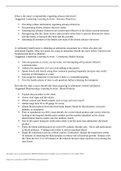Samenvatting
Summary of financial accounting 2
- Instelling
- Universiteit Van Amsterdam (UvA)
This document is a summary of the theory needed for the exam of he course Financial Accounting 2 (course code: 6013B0511Y). The summary includes the chapters 1-15, 18 & 23 of the book 'Intermediate Accounting: IFRS Edition (fourth edition)' by Kieso, D.E., Weygandt, J.J. & Warfield, T.D..
[Meer zien]














